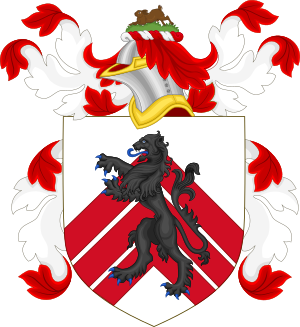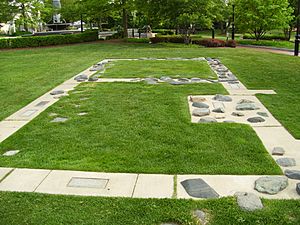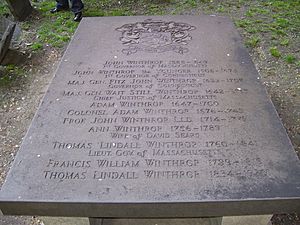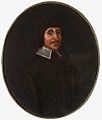John Winthrop facts for kids
Quick facts for kids
John Winthrop
|
|
|---|---|
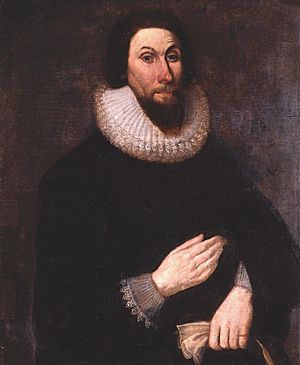 |
|
| 2nd, 6th, 9th, and 12th Governor of the Massachusetts Bay Colony | |
| In office 1630–1634 |
|
| Preceded by | John Endecott |
| Succeeded by | Thomas Dudley |
| In office 1637–1640 |
|
| Preceded by | Henry Vane |
| Succeeded by | Thomas Dudley |
| In office 1642–1644 |
|
| Preceded by | Richard Bellingham |
| Succeeded by | John Endecott |
| In office 1646–1649 |
|
| Preceded by | Thomas Dudley |
| Succeeded by | John Endecott |
| Commissioner for Massachusetts Bay | |
| In office 1643–1643 Serving with Thomas Dudley
|
|
| Preceded by | Office established |
| Succeeded by |
|
| In office 1645–1645 Serving with Herbert Pelham
|
|
| Preceded by |
|
| Succeeded by | Herbert Pelham |
| Personal details | |
| Born | 12 January 1587/8 Edwardstone, Suffolk, England |
| Died | March 26, 1649 (aged 61) Boston, Massachusetts Bay Colony |
| Spouses |
|
| Education | Trinity College, Cambridge |
| Profession | Lawyer, governor |
| Signature |  |
John Winthrop (born January 12, 1588 – died March 26, 1649) was an English Puritan lawyer. He was a key leader in starting the Massachusetts Bay Colony. This was the second big English settlement in New England, after Plymouth Colony.
Winthrop led the first large group of colonists from England in 1630. He served as governor for 12 of the colony's first 20 years. His ideas and writings, especially his vision of the colony as a "city upon a hill", greatly shaped New England. He influenced the governments and religions of Massachusetts and nearby colonies.
Winthrop came from a wealthy family. He studied law and became a respected landowner in England. He joined the Massachusetts Bay Company in 1629. This was when King Charles I started to crack down on Puritans. In October 1629, Winthrop was chosen as governor. He led colonists to the New World in April 1630. They founded many towns around Massachusetts Bay and the Charles River.
From 1629 until his death in 1649, he was governor or deputy governor for 18 years. He tried to be fair in the colony, which was very religious. He sometimes disagreed with others, like Thomas Dudley and Roger Williams. Winthrop was a respected leader. He believed that only certain religious people should vote. He also thought that too much democracy was not good. His strong, religious rule influenced how other colonies were formed.
Winthrop's son, John Winthrop the Younger, helped start the Connecticut Colony. John Winthrop himself wrote an important history of the early colonial period. Many famous Americans are his descendants. His writings still influence politicians today.
Contents
Early Life in England
John Winthrop was born on January 12, 1588, in Edwardstone, Suffolk, England. His parents were Adam and Anne Winthrop. His father's family was successful in the cloth business. His father was also a lawyer and owned much land. John's mother's family was also well-off.
When John was young, his father became a leader at Trinity College, Cambridge. John's uncle moved to Ireland. The Winthrop family then lived at Groton Manor. John was taught at home first. He likely went to grammar school in Bury St. Edmunds. He learned a lot about religion from his father and clergymen.
He started at Trinity College in December 1602. He met John Cotton and John Wheelwright there. These men also became important in New England. He was close friends with William Spring. Spring later became a Puritan Member of Parliament.
In 1604, Winthrop met Mary Forth in Essex. He was impressed by her. He left Trinity College to marry her on April 16, 1605. Mary and John had five children. Only three lived to be adults. Their oldest son was John Winthrop the Younger. He became a governor in Connecticut Colony. Mary died in 1615 after giving birth.
In 1613, John's father gave him the family lands in Groton. John then became the main landowner there.
Working as a Leader
As the main landowner, Winthrop managed the estate. He also practiced law in London, meeting important business people. He was chosen to be a county commission of the peace. This job let him deal with county issues, like roads and licenses. He also acted as a local judge for small crimes on his land. This role helped him meet other important lawyers and landowners.
Winthrop wrote about his religious life in a journal starting in 1605. He wrote about his struggles and his wish to be a better person. He prayed for God to "give me a new heart." He was more religious than his father.
His first wife Mary died in 1615. He married Thomasine Clopton on December 6, 1615. She was very religious. Thomasine died on December 8, 1616, after childbirth. The baby also died.
Around 1613, Winthrop studied law at Gray's Inn. He did not become a full lawyer. Through his legal connections, he met the Tyndal family. He began to court Margaret Tyndal in 1617. She was the daughter of a judge. Her family first did not like the marriage because of money. Winthrop said his strong faith was more important than money. They married on April 29, 1618. They lived in Groton. Winthrop also worked in London. His oldest son, John Jr., sometimes helped Margaret manage the estate.
Why They Sailed to America
In the 1620s, life became hard for Puritans in England. King Charles I became king in 1625. He was married to a Catholic. King Charles did not like religious groups, like the Puritans, who did not fully follow the Church of England. This made Puritan leaders think about moving to the New World to escape problems.

The first successful religious colony in the New World was Plymouth Colony in 1620. In 1628, some investors formed the New England Company. It was later called the Massachusetts Bay Company in 1629. This company received a special paper from the king to govern land between the Charles and Merrimack Rivers. They sent a small group of settlers led by John Endecott to prepare the way. Winthrop was not involved at first. But he likely knew about the company's plans.
In March 1629, King Charles closed Parliament. He ruled alone for eleven years. This worried the company's leaders. In July, the governor suggested moving the company's charter and government to the colony. Winthrop also lost his job in London because of the crackdown on Puritans. He wrote that God would "provide a shelter" for them. He became very involved with the company. By August, he strongly supported moving to America. He wrote eight reasons why they should go.
On October 20, the company chose a new governor. Winthrop was seen as the most dedicated. He won the election. He then started to get ships and supplies ready for the journey. He also found people with special skills, like pastors, for the new colony.
Winthrop's wife, Margaret, was expecting a baby. They decided she would come later. She joined him in 1631. To stay connected, they agreed to think of each other every Monday and Friday evenings. Winthrop also convinced his grown sons to join. His son Henry sailed with him in 1630. Winthrop sold most of his property before leaving.
Winthrop's Family Symbol
John Winthrop used a special family symbol, called a coat of arms. This symbol was given to his uncle in 1592. His sons also used it. You can see this symbol on his tombstone in Boston. It is also used by Winthrop House at Harvard University. The symbol shows three red V-shapes on a white background, with a black lion standing over them.
Life in Massachusetts Bay Colony
Arriving in the New World
On April 8, 1630, four ships left England. Winthrop and other leaders were on board. Winthrop sailed on the Arbella with his two young sons. These ships were part of a larger group of 11 ships. About 700 people traveled to the colony. Winthrop's son Henry sailed on another ship.
Winthrop wrote a sermon called A Modell of Christian Charity. He gave this speech either before or during the trip. It talked about how to keep the Puritan society strong in faith. It also compared their journey to the story of Exodus from the Bible. In it, he used the famous phrase "City upon a Hill." He meant that the colonists should be a good example for everyone. He also said that all people, rich or poor, were important to the community.
The ships arrived at Salem in June. John Endecott welcomed them. Winthrop and his deputy, Thomas Dudley, found Salem too small. They explored the area. They first chose Charlestown for the main settlement. But it did not have enough good water. So, they moved to the Shawmut Peninsula. This is where the city of Boston is today.
It was late in the season. The colonists decided to spread out their settlements. This would make it harder for enemies to attack one spot. These settlements became Boston, Cambridge, Roxbury, Dorchester, Watertown, Medford, and Charlestown.
The colony faced many diseases in its first months. About 200 people died in 1630, including Winthrop's son Henry. About 80 others went back to England. Winthrop worked hard alongside everyone else. He encouraged others by working with his own hands. This made sure "there was not an idle person" in the colony.
Winthrop built his house in Boston. He also had a large farm called Ten Hills Farm. He owned a ship called Blessing of the Bay. He used it for trading along the New England coast.
Winthrop and Dudley had some disagreements. Dudley built his home in Newtown (now Cambridge). The council had agreed to make Newtown the capital. But Winthrop decided to build his home in Boston. This upset Dudley. They later made up. They even named two large rocks "Two Brothers" where their lands met. This was to remember that their children married each other.
How the Colony Was Governed
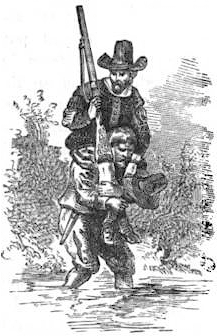
The colony's charter said there should be a governor, deputy governor, and 18 assistants. These assistants were like a council. All these leaders were to be elected each year by the colony's freemen. At first, only eight men were in the General Court. They decided that the governor should be elected by the assistants. Winthrop was elected governor three times this way. The General Court allowed many settlers to join. But it also said that all freemen had to be church members. Many new people came to the colony in 1633 and 1634. This was after William Laud, who was against Puritans, became a powerful church leader in England.
In 1634, the towns wanted to see the charter. They learned that the freemen, not the assistants, should elect the governor and make laws. Winthrop agreed about the elections. After that, freemen voted secretly. But he said that lawmaking would be hard with so many freemen. So, each town chose two people to represent them in the General Court. In a surprising turn, Thomas Dudley, who was against popular elections, won the 1634 election for governor.
In the late 1630s, people wanted written laws. They felt that judges' decisions were sometimes unfair. Winthrop did not want written laws. He believed in common law, which allowed judges to decide cases based on their unique facts. He also said the charter did not allow laws that went against English law. The Massachusetts Body of Liberties was finally adopted in 1641.
In the 1640s, there were arguments about the power of the leaders. In one case about a lost pig, the assistants sided with a merchant. A widow appealed to the General Court, which sided with her. The assistants then said they could overrule the General Court. Winthrop argued that experienced leaders should be able to check the democratic General Court. He said that democracy was "the meanest and worst of all forms of government."
In 1645, Winthrop was accused of interfering in a local dispute. This was about choosing a new leader for the Hingham militia. Winthrop had some people jailed. A minister from Hingham, Peter Hobart, questioned Winthrop's authority. He called Winthrop's actions unfair. Winthrop stepped down from his judge's seat to defend himself. He argued that he had not acted alone. He also said judges are not usually punished for mistakes they make. He was found not guilty.
Another big issue happened in 1647. A petition asked for voting rights for all English people, not just church members. Winthrop and the other leaders rejected this. They even fined and jailed the people who signed the petition.
Working with Native Americans
Winthrop generally tried to be fair and diplomatic with the local Native American groups.
The colonists usually tried to buy land from the Native Americans. But they also believed in a policy called vacuum domicilium. This meant that if land was not being actively used, like having houses or fences, it could be claimed. This included lands used only seasonally by Native Americans for hunting or fishing. Winthrop believed that "more advanced" peoples had greater rights to the land.
However, differences in culture and trade led to conflicts. The Pequot War was the first major war. Winthrop was on the council that sent an expedition to raid Native American villages. Winthrop also encouraged Roger Williams to get the Narragansetts to join the colonists against the Pequots. The war ended in 1637. The Pequots were defeated. Some survivors were sent to other tribes or shipped to the West Indies.
Slavery in the Colony
Slavery was already in the Massachusetts Bay area before Winthrop arrived. Samuel Maverick had slaves there in 1624. After the Pequot War, many captured Pequot warriors were sent to the West Indies as slaves. Winthrop himself owned one male and two female Pequot slaves.
In 1641, the Massachusetts Body of Liberties was created. It included rules about slavery. Winthrop was part of the group that wrote this code.
Trade and Other Colonies
Problems in England led to the English Civil War. This meant fewer people and supplies came to the colonies. So, the colonists started trading more with other colonies. This included English colonies like Barbados (a source of cotton) and the French colony of Acadia.
French Acadia was in what is now Maine, New Brunswick, and Nova Scotia. It was having its own civil war. English colonists started trading with one leader, Charles de Saint-Étienne de la Tour, in 1642. His opponent warned Boston traders to stay away. In 1643, la Tour came to Boston asking for military help. Governor Winthrop refused to send official help. But he allowed la Tour to recruit volunteers from the colony.
This decision caused a lot of criticism. People worried that Winthrop had shown the French the colony's defenses. The 1644 election was about Winthrop's policy. He lost the election. The Acadian conflict ended with la Tour's opponent winning. In 1646, Winthrop was governor again. The French governor came to Boston asking for payment for damages. Winthrop gave him a fancy chair to calm him down.
Winthrop's Land and Family
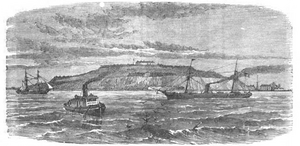
Besides his government duties, Winthrop owned a lot of land. He owned Ten Hills Farm. He also owned land that became the town of Billerica. He owned Governors Island in Boston Harbor and Prudence Island in Narragansett Bay. He also traded furs with William Pynchon. Governors Island was named after him. It stayed in his family until 1808.
His farm at Ten Hills had problems. The person managing it made bad money deals. This caused money problems for Winthrop. The colony started paying him a salary, which he had refused before. They also paid his expenses for official duties. People also donated money to help him. The colony gave his wife 3,000 acres (12 km2) of land.
His wife Margaret arrived in 1631. Their baby daughter died during the trip. Margaret and John had two more children in New England. Margaret died on June 14, 1647. Winthrop married his fourth wife, Martha Rainsborough, in 1648. They had one child.
Winthrop died naturally on March 26, 1649. He is buried in the King's Chapel Burying Ground in Boston. His wife Martha and five sons survived him.
Winthrop's Writings and Impact
Winthrop did not publish much during his lifetime. But he constantly wrote about historical events and religious ideas. His most important writings were A Modell of Christian Charity (1630) and The History of New England (1630–1649). His history was not published until the late 1700s.
A Model of Christian Charity
John Winthrop wrote A Model of Christian Charity as a sermon. He gave it either before or during the 1630 trip to North America. It explained his ideas for keeping the Puritan society strong in faith. It also talked about the challenges they would face in the New World. He used the phrase "city upon a hill" from the Bible. He meant that the colonists had a special agreement with God. They were to create a holy community.
He told the colonists to "bear one another's burdens." He wanted them to see themselves as a "Body of Christ, knitt together by Love." He urged them to be even stricter in their religion than the Church of England. Their goal was to build a model state. If they did this, God would make them "a prayse and glory."
Winthrop's sermon is often seen as an early idea of American exceptionalism. This is the belief that America is special. However, recent studies show that the speech was not very famous at the time. It was not published until the 1800s.
The History of New England
Winthrop kept a journal of his life and experiences. It started with his ocean journey and continued through his time in Massachusetts. His journal is seen as the main source for the history of Massachusetts in the 1630s and 1640s.
The first two parts of his journal were published in 1790. The third part was found in 1816. The complete journals were published in 1825 and 1826. The second part was lost in a fire in 1825. The other two parts are now at the Massachusetts Historical Society.
The journal started as a daily record of the ocean crossing. Over time, he wrote less often but in more detail. By the 1640s, it became more like a history book. Winthrop wrote about his personal life. This included his journey from England and his family joining him. He also wrote about important events in the Massachusetts Bay Colony. His early entries were mostly observations. Later, he wrote more about religious ideas and political matters.
Other Writings
Winthrop's first published work was likely The Humble Request of His Majesties Loyal Subjects (1630). This book defended why the colonists left England. It also said they were still loyal to the King and the Church of England.
He also wrote a private religious journal called Experiencia. In it, he wrote about his religious experiences. Later, he wrote A Short Story of the rise, reign, and ruine of the Antinomians. This book described a religious disagreement in 1636 and 1637. It was published in London in 1644.
According to one writer, Winthrop's writings aimed to understand God's plan in events. They also aimed to explain the special role New Englanders believed they had.
Winthrop's Lasting Impact
Winthrop's "city upon a hill" idea has become a lasting symbol in American politics. Many American politicians have quoted him. In the late 1800s and early 1900s, some critics did not like Puritan rule. They saw Winthrop as a "lost Founding Father." Political scientist Matthew Holland says Winthrop is a founder of both America's best and worst qualities. He points to Winthrop's calls for kindness and public involvement. But he also notes what he sees as strictness and exclusion.
In 1645, Winthrop gave a speech about two kinds of freedom. Natural liberty was doing whatever one wanted, good or bad. He believed this should be controlled. Civil liberty was the freedom to do good. Winthrop strongly believed that civil liberty was the government's goal. He thought the government should serve the people and promote justice. He showed this by passing laws. For example, he required parents to educate their children and servants. He also supported teachers with public money. Winthrop wanted the colony to work as one unit. He was a respected leader.
Many modern politicians refer to Winthrop's writings. These include John F. Kennedy, Ronald Reagan, and Sarah Palin. Reagan called Winthrop an "early 'Freedom Man'" who came to America for freedom.
Winthrop is a character in Catharine Sedgwick's 1827 novel Hope Leslie. He also appears briefly in Nathaniel Hawthorne's The Scarlet Letter.
Thousands of people today are Winthrop's descendants. His son John was the first governor of the Saybrook Colony. Later generations of his family were active in New England politics for a long time. The towns of Winthrop, Massachusetts, and Winthrop, Maine, are named after him. Winthrop House at Harvard University and Winthrop Hall at Bowdoin College are also named in his honor.
There are also squares named after him in Boston, Cambridge, and Brookline. The Winthrop Building in Boston is on the site of one of his homes. It is one of the city's first skyscrapers. NYU Langone Hospital in Mineola, New York, was named Winthrop Hospital in 1986. It was named for his descendant, Robert Winthrop.
A statue of Winthrop is in the National Statuary Hall Collection in the United States Capitol in Washington D.C..
After Winthrop died, the poet Benjamin Tompson wrote a tribute to him. It appeared in his work New-Englands Tears in 1676.
Images for kids
-
Winthrop's eldest son John Winthrop the Younger
See also
 In Spanish: John Winthrop para niños
In Spanish: John Winthrop para niños


